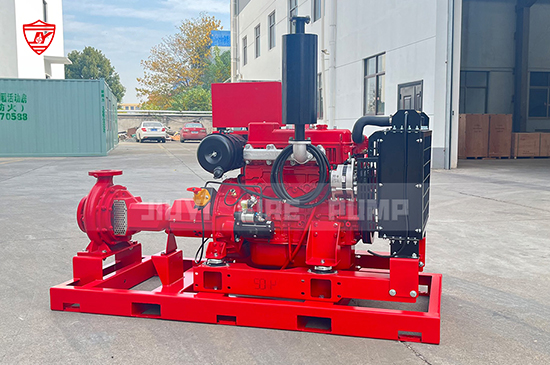Fire pumps are the heart of many fire protection systems. Whether used in high-rise buildings, industrial facilities, or warehouses, they play a critical role in delivering adequate water pressure during a fire emergency. As a fire pump manufacturer, we know that reliability and longevity come down to one core principle: proper maintenance.
Without routine care, fire pumps are at risk of premature failure, non-compliance with standards, and serious safety hazards. This article explores how to maintain your fire pump system to ensure a longer operational lifespan and higher system reliability.

A fire pump is not something you want to fail during a fire event. Routine maintenance ensures:
Compliance with NFPA 25 regulations.
Operational readiness in emergencies.
Longer equipment lifespan and lower long-term costs.
Reduced repair downtime and expense.
Neglecting fire pump maintenance can result in system failure when you need it most. Just like a car engine, your fire pump needs consistent checks, lubrication, and testing.
The NFPA 25: Standard for the Inspection, Testing, and Maintenance of Water-Based Fire Protection Systems is the benchmark for fire pump upkeep.
NFPA 25 requires:
Weekly inspections
Monthly no-flow testing
Annual flow testing
Internal inspections (as per pump type)
Following these standards helps maintain optimal function while avoiding compliance violations.
Inspect your fire pump system weekly. Use a checklist to cover critical items such as:
Pump casing and base condition
Electrical connections or diesel fuel levels
Alignment and mounting bolts
System pressure gauges
Suction and discharge lines
Look for any leaks, corrosion, vibrations, or abnormal noises that might indicate early wear.
Like any mechanical equipment, friction can cause excessive wear. Ensure:
Bearings are greased as per manufacturer specs.
Motors are lubricated according to schedule.
Couplings and rotating parts are inspected for smooth operation.
Never over-lubricate. Excess grease can attract dirt and create blockages.
Misalignment between the pump and driver (electric motor or diesel engine) is a major cause of wear. Misalignment leads to:
Shaft damage
Bearing failure
Excess vibration and noise
Use laser alignment tools or dial indicators to inspect and correct alignment at regular intervals, especially after transportation or repair.
According to NFPA 25, run your fire pump once a week (electric) or once a month (diesel) for 10 minutes. During test runs:
Monitor pressure and flow
Check for leaks or unusual noise
Record amperage and RPM
Observe automatic start/stop operation
Regular testing prevents rust, identifies mechanical issues early, and ensures emergency readiness.
Over time, seals and gaskets degrade, especially in high-pressure or fluctuating temperature environments. Replace them at signs of:
Dripping or leaking water
Cracked or brittle appearance
Poor sealing performance
Use manufacturer-approved parts to ensure compatibility and pressure rating.
Blocked filters restrict water flow and overwork the pump. Check:
Suction strainers
Control panel filters
Diesel engine air filters (for diesel fire pumps)
Clean or replace them regularly to maintain system efficiency.
Diesel engine fire pumps require extra attention:
Check battery voltage and terminals weekly.
Test the battery charger and alternator.
Ensure diesel tanks are full and fuel is fresh.
Inspect for microbial growth or water in the fuel tank.
Keep a fuel maintenance log to monitor quality and refill schedules.
Maintain a detailed log of inspections, repairs, replacements, and tests. Include:
Date and time of activities
Names of technicians
Readings taken
Any issues found and how they were resolved
Logs are essential for compliance and identifying recurring issues that may reduce pump life.
Even if you have an in-house team, make sure they:
Understand NFPA 25 requirements
Are trained in identifying wear and mechanical issues
Know how to handle emergency repairs
For complex issues or annual servicing, work with certified technicians or the original equipment manufacturer (OEM).
Even with regular maintenance, your system may show signs of trouble. Watch for:
Excessive vibration or noise during operation
Pressure drops during tests
Overheating of the motor or diesel engine
Increased power consumption
Inconsistent automatic starts
These are red flags that demand immediate inspection and repair.
Working with your fire pump manufacturer offers key benefits:
Access to original spare parts
Accurate maintenance manuals and intervals
Expert support for troubleshooting
Extended service life through proper OEM calibration
At Better Technology Group, we offer ongoing support, maintenance training, and customized service plans to help our clients keep their systems running for years.
Extending the life of your fire pump system isn’t just about saving money—it’s about safety, compliance, and performance when it matters most. With consistent inspections, proper lubrication, alignment checks, and regular testing, you can ensure your fire pump operates efficiently for many years.
A well-maintained fire pump isn’t just an asset—it’s a lifeline.
| Task | Frequency | Responsible Party |
|---|---|---|
| Visual Inspection | Weekly | Trained Personnel |
| No-Flow Test (Electric) | Weekly | Fire Safety Team |
| No-Flow Test (Diesel) | Monthly | Fire Safety Team |
| Full Flow Test | Annually | Certified Technician |
| Alignment Check | Bi-Annually | Maintenance Engineer |
| Lubrication | As per OEM | Trained Technician |
| Battery Check (Diesel) | Weekly | Trained Personnel |
| Fuel Quality Check | Monthly | Technician |